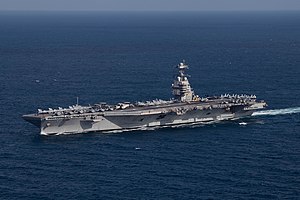Welf-class nuclear aircraft carrier: Difference between revisions
Drambenburg (talk | contribs) No edit summary |
Drambenburg (talk | contribs) |
||
| Line 41: | Line 41: | ||
==Design features== | ==Design features== | ||
Design features of the Welf-class include: | |||
*Advanced arresting gear (AAG) | |||
*Advanced automation, robotics, and state-of-the-art Artificial Intelligence (AI) allowing a crew of several hundred less than the Wilhelm-class cariers. | |||
*Updated anti-aircraft-and-missile missiles | |||
*Multifunction dual-band RADAR | |||
*Electromagnetic Aircraft Launch System (EMALS) replacing outdated steam catapults from older aircraft cariers | |||
*State of the art nuclear ractors and steam turbines, initially designed to power the [[Lange-class]] battleships' railguns | |||
*Reduced RADAR cross-section | |||
*Ability to carry up to 200 aircraft, typically 90, depending on configuration | |||
The largest visible difference from older iterations of aircraft cariers is the aftward movement of the superstructure. Due to the smaller acompanyment, the lifetime cost for the Welf-class is greatly reduced compared to the Wilhelm-class. | |||
==Development== | ==Development== | ||
===Planning=== | ===Planning=== | ||
Revision as of 23:11, 25 May 2023
 SMS Welf underway in the Cantalle Ocean on 9 October 2022.
| |
| General characteristics | |
|---|---|
| Class and type: | Welf-class |
| Length: | 1,092 ft (333 m) |
| Beam: |
|
| Height: | 250 ft (76 m) |
| Decks: | 25 |
| Propulsion: | Four shafts |
| Speed: | In excess of 30 knots (56 km/h; 35 mph) |
| Range: | ≈25 years before mid-life refuel |
| Complement: | 4539 (including air wing) |
| Armament: |
|
| Aircraft carried: | 75+ |
| Aviation facilities: | 1,092 ft × 256 ft (333 m × 78 m) flight deck |
The Welf-class nuclear aircraft carrier is a class of nuclear powered aircraft carriers currently being constructed for the Drambenburgian Kreigsmarine. The class, with two in active service and a planned total of four ships, is planned to add to the Navy's current carriers, the Wilhelm-class. The new vessels have a hull similar to the Wilhelm-class but introduce technologies such as the Electromagnetic Aircraft Launch System (EMALS), a second launch deck, a dedicated helipad, improved efficiency reactors, as well as other design features intended to improve efficiency and reduce operating costs, including sailing with smaller crews. The Welf-class is the world's largest aircraft carrier, surpassing the Talon-class nuclear aircraft carriers. The class of aircraft carriers is named after Erich Ramira von Welf who served as an admiral in the Drambenburgian Navy from 1880 until 1888 when he was elected Kaiser of Drambenburg. The second ship SMS Arminjon was comissioned April 18th, 2023.
Design features
Design features of the Welf-class include:
- Advanced arresting gear (AAG)
- Advanced automation, robotics, and state-of-the-art Artificial Intelligence (AI) allowing a crew of several hundred less than the Wilhelm-class cariers.
- Updated anti-aircraft-and-missile missiles
- Multifunction dual-band RADAR
- Electromagnetic Aircraft Launch System (EMALS) replacing outdated steam catapults from older aircraft cariers
- State of the art nuclear ractors and steam turbines, initially designed to power the Lange-class battleships' railguns
- Reduced RADAR cross-section
- Ability to carry up to 200 aircraft, typically 90, depending on configuration
The largest visible difference from older iterations of aircraft cariers is the aftward movement of the superstructure. Due to the smaller acompanyment, the lifetime cost for the Welf-class is greatly reduced compared to the Wilhelm-class.